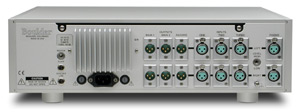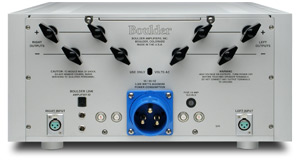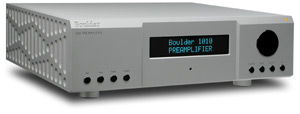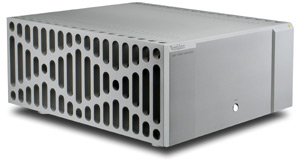 |
||||||
| January 15, 2005
In searching out review items, I do a lot of investigation -- on the Internet, on the phone, via e-mail, on trips. When I find a product that I think would make a good review candidate, I get busy making arrangements. When I find a product I’m really curious about, I hound people. This was the case with Boulder Amplifiers. Marc Mickelson and I went to Boulder, Colorado in the summer of 2003 and visited a number of manufacturers for SoundStage! factory-tour features. Boulder Amplifiers was the first stop. I was genuinely impressed, if a bit surprised, with what I saw. The growing trend of outsourcing manufacturing -- whether subassemblies or, in many cases, entire products -- was not at play at Boulder Amplifiers. In fact, the reverse was evident in every corner of the factory. The company had its own CNC machines busy creating all manner of aluminum chassis panels. Technicians, though not in huge numbers -- remember that these are not mass-produced products -- were soldering, testing, and bolting away. There was a fellow busy with a CAD (computer-aided design) program and yet another who wrote software for the various operating systems used in Boulder products. At the time Marc and I were visiting, Jeff Nelson, head engineer and sole proprietor of the company, had plans to expand the operation into an adjoining building. That expansion, I’ve come to find out, has since been implemented for even greater in-house manufacturing capability. All of this investment in company infrastructure is, clearly, a primary reason that Boulder products are expensive. Outsourcing to larger-capability production houses, or overseas to wage-challenged manufacturing plants, is a widely used cost-saving exercise within this, and most any, manufacturing industry. So then, what’s the payoff for doing it all yourself? Boulder Amplifiers’ Jeff Nelson would say "quality control," for one. When you specify and implement every aspect of design, manufacturing, and assembly, exactly what leaves through your door is your doing alone. Before I get to the operation and performance of the 1010 preamplifier ($12,000 USD) and 1060 stereo power amplifier ($20,750), it’s important to understand just how special the Boulder Amplifiers' build quality is. It exceeds, in attention to detail and quality control, that of any other electronics manufacturing firm with which I’ve had experience. Simply stated, it’s exceedingly close to perfect. The solder joints are all identically precise, with no flux left on the boards. The chassis panels fit together, not simply with screws but with dovetailed joints or precise, interlocking channels. The heatsinks, even on the 20"-plus 1060, are machined from a single block per side of aluminum. Manufacturing tolerances? Think Swiss-watch precision. Here’s an example: the top panels for both the 1010 and 1060 glide within precisely corresponding channels in the components’ side plates. There are no screws in view on top of the chassis, and the fit of the plate is perfectly snug but easily movable. The chassis construction is not only an elegant solution visually, but inert mechanically -- as if each piece were a solid brick. The heatsinks, in fact, are designed to avoid any ringing or resonance of any kind. There are no fins or protrusions, but instead a catacomb of various-sized perforations. Believe me when I tell you that these panels alone keep those CNC machines cranking. For those who have never seen a Boulder product up close and personal, here’s some perspective: The only other company that I’ve seen with the quality control and overall level of craftsmanship exhibited by Boulder Amplifiers is Wilson Audio Specialties. Both companies control manufacturing in-house to the nth degree. The subjects
Squarely in the middle of the front panel is a large mirror-finished display that comes alive with a bright-blue readout upon powering up. The volume control’s readout (200 0.5-dB steps) can easily be read across the room, though the brightness of this display can be adjusted for a more muted appearance if desired. Each input can be named via a massive library of available characters. Programming the unit is a snap, though there are a lot of options for customizing. The 1010 will remember your polarity setting for each source. As well, the input level for each source is adjustable. You can even program the output polarity for matching various amplifiers’ balanced-input pin configurations. This user interface is not only intuitive and completely functional, but addictive to use; the control wheel is weighted perfectly for just a hair of overshoot. You’ll find yourself adjusting this controller on your way to the kitchen even when you’re not listening to music -- it’s that cool. As stated above, the chassis of the 1010 is a marvel. Dovetails -- rarely see in aluminum construction -- join the panels together. The top plate sits on tiny rollers inset into channels within the side plates; it slides back and forth with almost hydraulic-like action. The remote control is a wavy block of aluminum that fits the hand perfectly. The buttons are stainless steel to match the 1010’s faceplate. It repeats most of the front-panel adjustments and adds polarity inversion. And yes, the remote is made in-house, too.
The insides are marvelously clean in appearance. Running from fore to aft and bolted to the bottom plate is a black enclosure that houses two potted 1500VA toroidal transformers. The 56 bipolar output devices (28 per channel) are sandwiched to the heatsinks with an aluminum bar and an unspecified damping material. Mounted very close these output devices are 48 (24 per side) filter capacitors. There’s virtually no internal wiring in the 1060; the exception to this is the output stage’s connection to the two sets of custom binding posts. Here, you’ll find a large-diameter silver braid soldered to polished gold-plated brass bus bars that couple the output posts to each other. The 1060, like the 1010, uses micro-circuitry throughout. This effectively reduces the signal-path length due to the densely packed nature of the technique. Smaller parts mean smaller boards and a shorter path. Boulder’s products are separated into two price tiers: the 1000 series, of which the 1010 and 1060 are central, and the 2000 series, roughly double the price of each corresponding 1000-series product. The 2000 series is, as you would expect, more expensive to produce. For example, the 1060’s big 600Wpc brother, the 2060, incorporates Boulder’s more costly discrete 993 gain stage. The 1060 uses a micro version, the 983. The 1000 series does trump its larger brethren in the dovetailed, channeled chassis construction. The 2000s use, in part, more conventional methods for securing panels together, and to me they are not as visually appealing. The Boulderlink Although the 1000 series is a few years old, the operating system used for integrating the components is more advanced than that of almost any other product line I’ve seen (although Gryphon does offer a similar, if not quite as comprehensive, setup). A custom connecting cable, bought from your Boulder dealer, allows the microprocessors within 1060 and 1010 to speak to one another. The 1010 will turn on the 1060, or multiple Boulder amps if you have them, in any sequence and at whatever intervals you choose. The 1010 also monitors the 1060’s operational status. Is the amplifier clipping (either voltage or current), overheating, or is there a protection fault? You’ll be notified via the 1010’s readout so you know exactly what action to take. You can almost think of the 1010/1060 combination as a 175-pound integrated amplifier: once the amp and preamp are connected, you interface with the 1010 alone. Performance
Ergonomically, the Boulder separates are a joy to use. Upon powering up, the front-panel-mounted LED on each component changes to amber from a constantly varying green-yellow-red rotation. The 1010’s readout, instantly after the unit is turned on, will let you know it’s "Waiting For Amps," as the hands on a small clock icon rotate. A series of four relays on the 1060 click and soon you’re in business. The first time I power up a new amp or preamp I immediately get a handle on how much residual noise is being produced by the new electronics. I just can’t tolerate humming and buzzing. With my ear placed precariously close to the tweeter of one of my Wilson Alexandria X-2 loudspeakers, and with no music playing, I could hear virtually nothing from the Boulder duo. Subjectively, this matches the Halcro dm68 monoblocks I’ve used in the same system. There was neither noise coming through the speakers nor any mechanical noise emanating from the components’ enclosures: no hum, no buzz, no nothing. The latter is a common plague with electronics that use large power supplies incorporating beefy transformers. It can be persistent and hard to get rid of. And once you notice it for the first time, perhaps when changing interconnects or speaker cables, it’s hard to ignore, even if it’s low in level. To follow up on the noise-floor performance, this time with music playing, I listened to some finely recorded jazz to assess the Boulders’ retrieval of low-level detail. David Chesky’s Swing Live [CHDVD222], recorded in a naturally yet intimately ambient venue -- a smoky jazz club in NYC -- allowed me to concentrate on each note of the guitar, bass, clarinet, and drums. There was no residue clouding the music or the faint crowd noises heard throughout and after each song; each strum of the guitar was delineated as an event unto itself, emerging from a black background to occupy the space of my listening room. If detail retrieval is your thing, you’ll get your money’s worth with the 1010 and 1060. Even as I listened to small-scale jazz and acoustic music I was aware that there was a bass presence just below the surface of the music that was waiting to get out. Call it authority, control, or just full-bandwidth power, the Boulder separates sounded big and commanding in the bass. To confirm my suspicions I inserted a disc that has obvious low-end energy. Dead Can Dance’s Into the Labyrinth [Warner Bros./4AD 45384-2] contains sustained bass that can become blurred if the speakers and amplifiers aren’t delineating every note. Listen to "Spirit Dance" and "The Ubiquitous Mr. Lovegrove" over the wrong system and you’ll not wonder why some audiophiles choose to avoid poor bass and stick with minimonitors. The bass line in the latter cut underscored the music with an energy that completely locked me and my room into a trance. Sarah McLachlan’s Afterglow Live on DVD-Video is a fantastic concert that deserves her fans’ full attention. I was most entertained with the entire performance, though her love song and tribute to her husband, "Push," has become a favorite song as of late and was a particular treat. This track provides ample opportunity to assess clear, live, emotionally charged female vocals from an artist I’ve listened to for years. There was no question that my system, anchored by the Boulder duo, was in top form. Piano and voice were clear and vivid, with no veiling or smearing; it was just dead neutral. The soundstage was portrayed with equal parts precision, expansiveness, and realistic scaling. I could not have asked for better, more accurate sound. Even the highest frequencies were balanced perfectly with the rest of the music. I heard detail in spades, but no grain or brightness. ...versus Goliaths
The Boulder 1010/1060 combo seemingly combined the strengths of two of the finest-performing preamp/power-amp combinations I’ve heard to date: the Halcro dm68/dm8 ($37,990/$12,990) and Gryphon Antileon Signature/Sonata Allegro ($24,000/$12,500). The bass drive, control, authority, and slam displayed by the big Gryphon separates were wholly matched by the Boulder duo. Perhaps a little tighter and slightly less round than that of the Gryphons, the Boulders’ low end was massively impactful in the best tradition of the finest solid-state products I’ve heard. Over the years I’ve found that power ratings are misleading when it comes to real-world performance; the more powerful amplifier on paper doesn’t necessarily sound more powerful in the listening room. The full-class-A Gryphon Antileon Signature, at 150Wpc, has more grunt than the 225Wpc Halcro dm68s, for instance. The Boulder 1060, powerfully rated at 300Wpc, does seem to have limitless power reserves. Subjectively, it does not sound "more powerful," in the audiophile sense, than the Gryphon Antileon Signature. At the end the day either of these beasts will give you plenty of juice for the most bombastic dynamics you’re likely to encounter on a recording. Where the Boulder 1060 trumps the Antileon Signature is the noise department. It is dead quiet, displaying tomb-like silence just like the ultra-quiet Halcro dm68s. The Halcros are the picture of precision, resolution, and the straight-wire-with-gain approach to amplification. Although I certainly can’t say how close the Boulder separates would come on the test bench to matching Halcro’s low distortion -- reportedly the specs of the Halcros surpass just about anything out there -- in actual use I sure couldn’t say that the dm68s were better in this regard. Both the Boulder and the Halcro combos produce sound from a dead-silent background, and stand together at the top of the heap in this regard. Resolution from both products goes to the very depths of the recording (whether this is good or bad depends on the recording). In that sense, both products are fantastic reviewers’ tools. In the bass, however, there was no contest. The Boulder 1060 displayed more drive and authority than the Halcro amps in my system. Lastly, the Boulder user interface is hands down the best I’ve used. I cannot pretend to feel impartial about colors. I rejoice with the brilliant ones and am genuinely sorry for the poor browns. With a number of fantastic products behind me, and a slew of potential contenders lined up for 2005, it would seem wise to just wait it out, listen to everything out there, and only then make a decision about what I personally want to buy for a reference preamplifier/amplifier combination. However, it is with singular confidence that I can say I’ve never heard more satisfying electronics than the Boulder 1010 and 1060. When you add this to their unparalleled build quality and ergonomic thoughtfulness, what else could I ask for? So yeah, I bought them. If you value the attributes I’ve described above, you’d be wise to hear and experience these products yourself. They’re simply the best I’ve had in my system, and they’re staying. ...Jeff Fritz Manufacturer contact information: Boulder Amplifiers, Inc. Email: sales@boulderamp.com
Ultra Audio is part of the SoundStage! Network. |

 The 1010 preamplifier
(18"W x 5.75"H x 15.75"D, 35 pounds) appears simple yet precise upon first
inspection. The front panel contains, on the left side, four round buttons of polished
stainless steel that correspond each to its four inputs. Mirrored on the right side are
four identical buttons for power, dimming the display, mute, and balance. Directly above
the right bank of buttons is the large flywheel-type controller used for adjusting volume
and all of the 1010’s programming functions. The back panel contains only XLR inputs
and outputs: three inputs for the line-level connections and a fourth for the internal
MM/MC phono stage, and two sets of main outputs along with a set of record outputs. One
set of inputs can be programmed to unity gain for home-theater-bypass operation. Needless
to say, the 1010 is fully balanced.
The 1010 preamplifier
(18"W x 5.75"H x 15.75"D, 35 pounds) appears simple yet precise upon first
inspection. The front panel contains, on the left side, four round buttons of polished
stainless steel that correspond each to its four inputs. Mirrored on the right side are
four identical buttons for power, dimming the display, mute, and balance. Directly above
the right bank of buttons is the large flywheel-type controller used for adjusting volume
and all of the 1010’s programming functions. The back panel contains only XLR inputs
and outputs: three inputs for the line-level connections and a fourth for the internal
MM/MC phono stage, and two sets of main outputs along with a set of record outputs. One
set of inputs can be programmed to unity gain for home-theater-bypass operation. Needless
to say, the 1010 is fully balanced. The direct-coupled,
class-AB, fully balanced 300Wpc 1060 stereo amplifier is large but not obnoxiously so
(18"W x 9.5"H x 22.25"D, 140 pounds). The side panels, with their
aforementioned catacomb-like heatsinking, are narrowly dimensioned -- only slightly
thicker than the front panel. When you take this dimension into account -- versus the
fin-like protrusions of most large solid-state amplifiers -- it’s evident that most
of the width of the amplifier is used for the internal compartment.
The direct-coupled,
class-AB, fully balanced 300Wpc 1060 stereo amplifier is large but not obnoxiously so
(18"W x 9.5"H x 22.25"D, 140 pounds). The side panels, with their
aforementioned catacomb-like heatsinking, are narrowly dimensioned -- only slightly
thicker than the front panel. When you take this dimension into account -- versus the
fin-like protrusions of most large solid-state amplifiers -- it’s evident that most
of the width of the amplifier is used for the internal compartment.


